Exploring the Health Benefits of Wine
A substantial body of research suggests that moderate consumption of red wine may protect against cardiovascular disease, loss of bone density, and dementia.
Alcoholic beverages have been part of the human diet for thousands of years. Egyptian paintings show alcohol as integral to the lives of the nobility. And for good reason—before the relatively recent availability of clean, pure water, alcoholic beverages may have been the only safe liquids to drink!
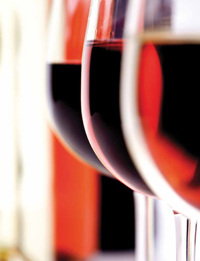 Although excessive alcohol consumption is clearly detrimental to health, drinking small to moderate amounts of alcohol has been shown to have a number of health benefits, most notably improving coronary artery disease (Klatsky, 2009; Kloner and Rezkalla, 2007). In 1819, Samuel Black, an Irish physician, noted a high prevalence of angina pectoris in Ireland and a low prevalence in France. He attributed this observation to “the French habits and modes of living, coinciding with the benignity of their climate and peculiar character of their moral affections.”
Although excessive alcohol consumption is clearly detrimental to health, drinking small to moderate amounts of alcohol has been shown to have a number of health benefits, most notably improving coronary artery disease (Klatsky, 2009; Kloner and Rezkalla, 2007). In 1819, Samuel Black, an Irish physician, noted a high prevalence of angina pectoris in Ireland and a low prevalence in France. He attributed this observation to “the French habits and modes of living, coinciding with the benignity of their climate and peculiar character of their moral affections.” It wasn’t until 160 years later that A.S. St. Leger and colleagues published the first international comparison study on wine consumption and mortality (St. Leger et al., 1979). The principal finding was a strong and specific negative association between ischaemic heart disease deaths and alcohol consumption, which the authors concluded were “wholly attributable to wine consumption” (See Figure 1). The hypothesis that a French diet of cheese, chocolate, and wine could be associated with improved cardiovascular health became known as the French Paradox (Renaud and de Lorgeril, 1992), and when the television news program “60 Minutes” featured a segment on this in November 1991, red wine sales increased 44% in the United States.
Numerous studies over the past three decades have shown that drinking small to moderate amounts of alcohol can reduce the risk of cardiovascular disease and have consistently demonstrated a J- or U-shaped relationship between alcohol consumption and total mortality or mortality from heart disease (Di Castelnuovo et al., 2006; Djoussé et al., 2009), as shown in Figure 2. But the question of whether wine is really more healthful than beer or spirits has been a very controversial one. Although there is still no consensus on this issue, a recent review by Lindberg and Amsterdam (2008) concluded: “… it would seem reasonable to recommend that patients who currently drink try to move towards moderate consumption of wine over that of beer and spirits.”
This conclusion is supported by a large epidemiological study conducted in Northern California by Arthur Klatsky and his colleagues in more than 128,000 adults (Klatsky et al., 2003). In this study, the risk of mortality from coronary disease was reduced at moderate intakes from wine, beer, and liquor, but wine was the most beneficial in this regard.
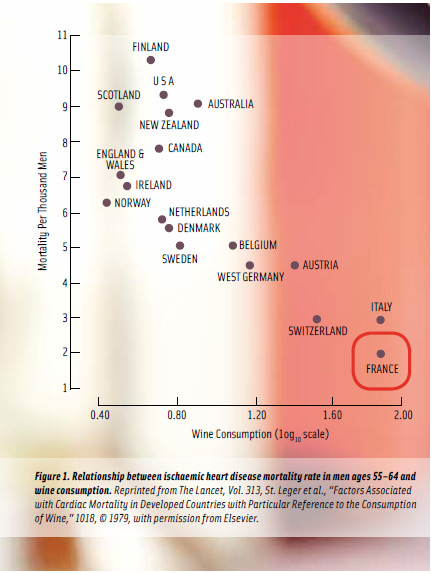
As shown in Figure 3, mortality from coronary disease was reduced about 60% in a subset of those exclusively consuming up to 1–2 servings of wine per day. Beer was also protective at moderate consumption levels and this has been demonstrated in several other studies (Bamforth, 2004).
There are several possible mechanisms by which alcohol may protect against cardiovascular disease, including increasing high density lipoprotein (HDL) cholesterol, reducing low density lipoprotein (LDL) cholesterol, decreasing LDL oxidation, reducing blood fibrinogen, and other antithrombotic actions (Klatsky, 2009). Further, red wine is high in phenolic compounds, which are natural antioxidants (López-Vélez et al., 2003). The level of phenolics in wines is highly variable due to differences in grape varietals as well as processing methods(Corder et al., 2006). White wines are lower in phenolics due to quickly pressing the juice away from the grape solids (skin and seeds), while reds are made by fermenting the juice in the presence of grape solids (Waterhouse, 2002). Red wine is also high in resveratrol (3,5,4’-trihydroxystilbene), a phytoalexin found in high concentrations in the skin of red grapes (Baur and Sinclair, 2006).
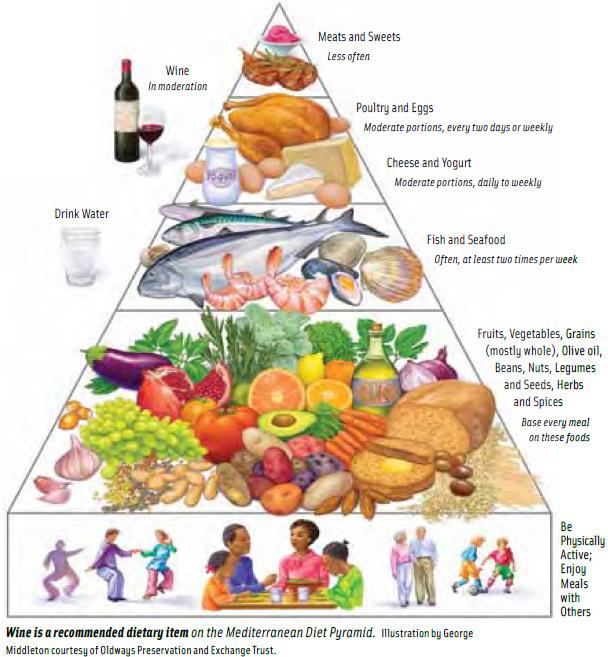
In November 2006, a landmark study published in Nature found that high doses of resveratrol improved overall health and significantly extended longevity in mice fed a high-calorie diet (Baur et al., 2006). The exact mechanism of resveratrol is not yet known, but the researchers believe resveratrol may be activating a longevity gene called sirtuin-1 (Howitz et al., 2003). Recent research also suggests that resveratrol has anti-inflammatory effects (Issuree et al., 2009). It should be noted again that industrial doses of resveratrol have been used in these studies.
--- PAGE BREAK ---
Wine drinkers may be more protected from cardiovascular disease because they lead healthier lifestyles compared to those who prefer beer or spirits (Barefoot et al., 2002). A recent study investigated whether people who buy wine buy healthier food items than those who buy beer (Johansen et al., 2006). Investigators collected data from approximately 3.5 million random transactions from 98 outlets of two large Danish supermarket chains over a 6-mo period. Those who bought wine tended to purchase healthier food items (olives, fruits or vegetables, and low-fat products) while beer buyers bought more cold cuts, chips, butter, and meats. Wine drinkers also tended to buy more items associated with the Mediterranean diet. Wine is a recommended dietary item on the Mediterranean Diet Pyramid at a level of one 5-oz glass per day for women and two for men (http://www.oldwayspt.org/med_pyramid.html).
In addition to improving heart health, moderate consumption of alcohol, including wine, may also lower the risk of related diseases, including type 2 diabetes (Wannamethee et al., 2003), hypertension (Sesso et al., 2008), and stroke (Reynolds et al., 2003). Increasing literature also suggests that moderate alcohol consumption may improve cognitive function, including affording some protection against dementia and Alzheimer’s disease (Panza et al., 2009). In a recent 34-year prospective follow-up of 1,462 women in Göteborg, Sweden, wine consumption was highly protective against the development of dementia and the strongest protective effect was among women who consumed only wine (Mehlig et al., 2008).
Moderate alcohol consumption has also been associated with increased bone mineral density (likely due to resulting higher endogenous estrogen levels), which may reduce the risk of osteoporosis. This hypothesis was further strengthened by results from a recent study of nearly 6,000 participants in the Cardiovascular Health Study. After 12 years of follow-up, compared with abstainers, men and woman who consumed up to 14 drinks per week had 5% higher bone density of the total hip and femoral neck as well as a 20% reduction in hip fracture rate (Mukamal et al., 2007).
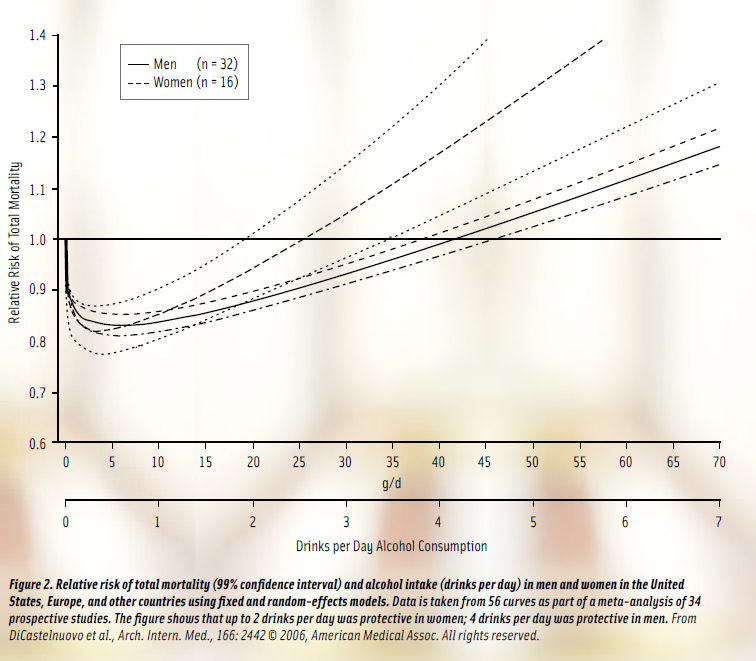
Although light to moderate alcohol consumption, particularly red wine, has been linked to numerous health benefits (chiefly related to the cardiovascular system), a note of caution may be in order with regard to cancer risk (Lauer and Sorlie, 2009). A recent prospective cohort study of 1.28 million middle-age women in the United Kingdom (the “Million Women Study”), who were followed for more than 7 years found that low to moderate alcohol consumption increased the risk of several types of cancer, particularly breast cancer. For each additional drink regularly consumed per day, there were 11 additional breast cancers per 1,000 women up to age 75 (Allen et al., 2009). The authors estimated that about 13% of cancers of the breast, aerodigestive tract, liver, and rectum could be attributed to alcohol. Clearly, those who choose to consume any type of alcohol, including wine, need to be aware of their own personal cancer risk profile and lifestyle habits. The U.S. Dept. of Agriculture Dietary Guidelines for Americans state: “Those who choose to drink alcoholic beverages should do so sensibly and in moderation—defined as the consumption of up to one drink per day for women and up to two drinks per day for men.” A standard drink is typically defined as 12 oz of regular beer, 5 oz of wine, or 1.5 oz of 80-proof distilled spirits.
In summary, light to moderate consumption of alcohol is clearly associated with cardiovascular and related health benefits but may increase the risk of certain types of cancer, including breast cancer in women. Although there is no consensus on whether red wine is more beneficial, it is the opinion of this author that the high concentration of antioxidant polyphenolics in red wine and the potential anti-inflammatory properties of resveratrol support the choice of red wine as the alcoholic beverage of choice in moderation.
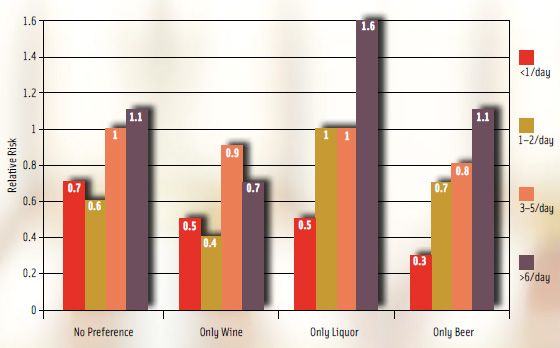
Clare M. Hasler, Ph.D., a Member of IFT, is Executive Director, Robert Mondavi Institute for Wine and Food Science, College of Agricultural and Environmental Sciences, University of California, Davis, 392 Old Davis Rd., Room 1027 Sensory Building, Davis, CA 95616 ([email protected]).
References
Allen, N.E., Beral, V., Casabonne, D., Kan, S.W., Reeves, G.K., Brown, A., and Green, J., on behalf of the Million Women Study Collaborators. 2009. J. Natl. Cancer Inst. 101: 296-305.
Bamforth, C.W. 2004. The impact of alcohol on health. In “Beer: Health and Nutrition.” pp. 120-154. Blackwell Publishing Professional, Ames, Iowa.
Barefoot, J.C., Grønbaek, M., Feaganes, J.R., McPherson, R.S., Williams, R.B., and Siegler, I.C. 2002. Alcoholic beverage preference, diet, and health habits in the UNC Alumni Heart Study. Am. J. Clin. Nutr. 76: 466-472.
Baur, J. and Sinclair, D.A. 2006. Therapeutic potential of resveratrol: the in vivo evidence. Nature Rev. 5: 493-506.
Baur, J.A., Pearson, K.J., Price, N.L., Jamieson, H.A., and Lerin, C. et al. 2006. Nature 444: 337-342.
Corder, R., Mullen, W., Khan, N.Q., Marks, S.C., Wood, E.G., Carrier, M.J., and Crozier, A. 2006. Red wine procyanidins and vascular health. Nature 444: 566.
Djoussé, L., Lee, I.-M., Buring, J., and Gaziano, N. 2009. Alcohol consumption and risk of cardiovascular disease and death in women. Potential mediating mechanisms. Circulation 120: 237-244.
Di Castelnuovo, A., Costanzo, S., Bagnardi, V., Donati, M.B., Iacoviello, L., and de Gaetano, G. 2006. Alcohol dosing and total mortality in men and women: an updated meta-analysis of 34 prospective studies. Arch. Intern. Med. 166: 2437-2445.
Howitz, K.T., Bitterman, K.J., Cohen, H.Y., Lamming, D.W., Lavu, S., Wood, J.G., Zipkin, R.E., Chung, P., Kisielewski, A., Zhang L.-L., Scherer, B., Sinclair, D.A. 2003. Nature 425: 191-196.
Issuree, P.D., Pushparaj, P.M., Pervaiz, S., and Melendez, A. 2009. Resveratrol attenuates C5ainduced inflammatory responses in vitro and in vivo by inhibiting phospholipase D and sphingosine kinase activities. FASEB J. 23(8): 2412-2424.
Johansen, D., Friis, K., Skovenborg, E., and Grønbaek, M. 2006. Food buying habits of people who buy wine or beer: cross sectional study. BMJ (January 20), doi:10.1136/ bmj.1136/bmj.38694.568981.80
Klatsky, A.L., Friedman, G.D., Armstrong, M.A., and Kipp, H. 2003. Wine, liquor, beer, and mortality. Amer. J. Epidemiol. 158(6): 585-595.
Klatsky, A. 2009. Alcohol and cardiovascular diseases. Expert Rev. Cardiovasc. Ther. 7: 499-506.
Kloner, R.A. and Rezkalla, S.H. 2007. To drink or not to drink? That is the question. Circulation 116: 1306-1317.
Lauer, M.S. and Sorlie, P. 2009. Alcohol, cardiovascular disease, and cancer: treat with caution. J. Natl. Cancer Inst. 101(5): 282-283.
Lindberg, M.L. and Amsterdam, E.A. 2008. Alcohol, wine and cardiovascular health. Clin. Cardiol. 31(8): 347-351.
López-Vélez, M., Martínez-Martínez, F., and Valle-Ribes, C. 2003. The study of phenolic compounds as natural antioxidants in wine. Crit. Rev. Food Sci. Nutr. 43(3): 233-244.
Mehlig, K., Skoog, I., Guo, X., Schütze, M., Gustafson, D., Waern, M., Östling, S., Björkelund, C., and Lissner, K. 2008. Alcoholic beverages and incidence of dementia: 34-year follow-up of the prospective population study of women in Göteborg. Amer. J. Epidemiol. 167: 684-691.
Mukamal, K.J., Robbins, J.A., Cauley, J.A., Kern, L.M., and Siscovick, D.S. 2007. Alcohol consumption, bone density, hip fracture among older adults: the cardiovascular health study. Osteoporos. Int. 18: 593-602.
Panza, F., Capurso, C., DiIntrono, A., Colacicco, A.M., Frisardi, V., Lorusso, M., Santamato, A., Seripa, D., Pilotto, A., Scafato, E., Vendemiale, G., Capurso, A., and Solfrizzi, V. 2009. Alcohol drinking, cognitive functions in older age, predementia, and dementia syndromes. J. Alzheimer’s Dis. 17(1): 7-31.
Renaud, S. and de Lorgeril, M. 1992. Wine, alcohol, platelets, and the French paradox for coronary heart disease. The Lancet 339: 1523-1526.
Reynolds, K., Lewis, L.B., Nolen, J.D., Kinney, G.L., Sathya, B., and He, J. 2003. Alcohol consumption and risk of stroke. A meta-analysis. JAMA 289: 579-588.
Sesso, H.D., Cook, N.R., Buring, J.E., Manson, J.E., and Gaiano, J.M. 2008. Alcohol consumption and the risk of hypertension in women and men. Hypertension 51: 1080-1087.
St. Leger, A.S., Cochraine, A.L., and Moore F. 1979. Factors associated with cardiac mortality in developed countries with particular reference to the consumption of wine. The Lancet 313: 1017-1020.
Wannamethee, S.G., Camargo, C.A., Manson, J.E., Willett, W.C., and Rimm, E.B. 2003. Alcohol drinking patterns and risk of Type 2 diabetes mellitus among younger women. Arch. Intern. Med. 163: 1329-1336.
Waterhouse, A. 2002. Wine phenolics. Ann. N.Y. Acad. Sci. 957: 21-36.
